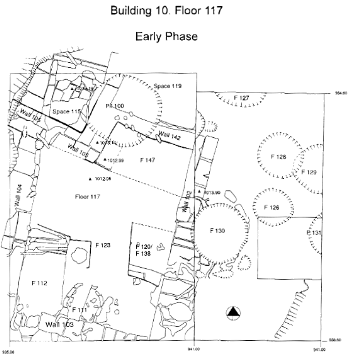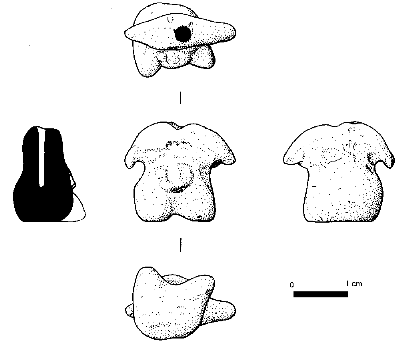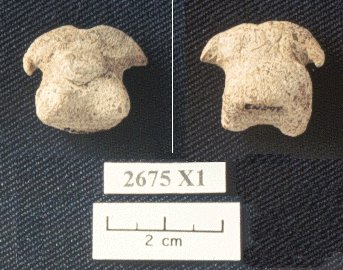THE SUMMIT EXCAVATIONS
by Kostas Kotsakis

Figure 16: Summit excavation area, early phase
During the 1997 season, the collaborative project of the University of Thessaloniki investigated further Building 10 (Level IV/V) and the midden material to its east, continuing the work which was started in 1996. In the "Summit" area, where Building 10 is located, another trench of 4 x 9 metres was opened to the East of the 1996 trench. So, the whole area investigated in 1997 measured 10 x 9 m (fig 16).
The main objective of the 1997 season was to clarify the stratigraphic sequence of Building 10, and establish its trajectory in time. An additional aim was to investigate the area surrounding the building, and explore the nature of deposits there.
Inside Building 10, work started with uncovering floor 117, which had been exposed during the 1996 season in the Southern part of the building. The whole area North of the E-W baulk was covered with that floor in a uniform way. It was very well preserved, and was formed by a layer of hard white plaster.
Much work was devoted to the clarification of the stratigraphic position of Wall 105, which forms the Northern end of Building 10. Wall 105 appears so far to be the oldest feature of the building, all other feature being later. However, its eastern end was found to overlay floor 117, which means that this part was built at a later stage, possibly in the same episode as the building of basin 134. In this specific part, i.e. the eastern extremity of the wall, the traces of an older platform, covered with red paint, were found under the foundations of wall 105.
Area East of Building 10. This area was opened in order to investigate the deposits which are related to midden activities. The area was disturbed by 6 pits, one of which was dated to the Early Byzantine period and the rest provisionally to the Chalcolithic. The deposits showed a perceptible change in character at the South part, where evidence of firing and burning was found. Two thin walls (144 and 132) defined an area where abundant traces of in situ fire were found. The conclusion is that this area was predominantly an open area of waste disposal. The evidence, however, shows that the area was used for other activities, too. Further analysis will define the character of this area more accurately.
Among the movable artefacts, apart from the usual quantity of bone and obsidian, notable is a human figurine found between walls 144 and 132, in the midden area, outside Building 10 (fig 17).
|
|
|
Figure 17a and b: Human Figurine found in the Summit Area in 1997. |

